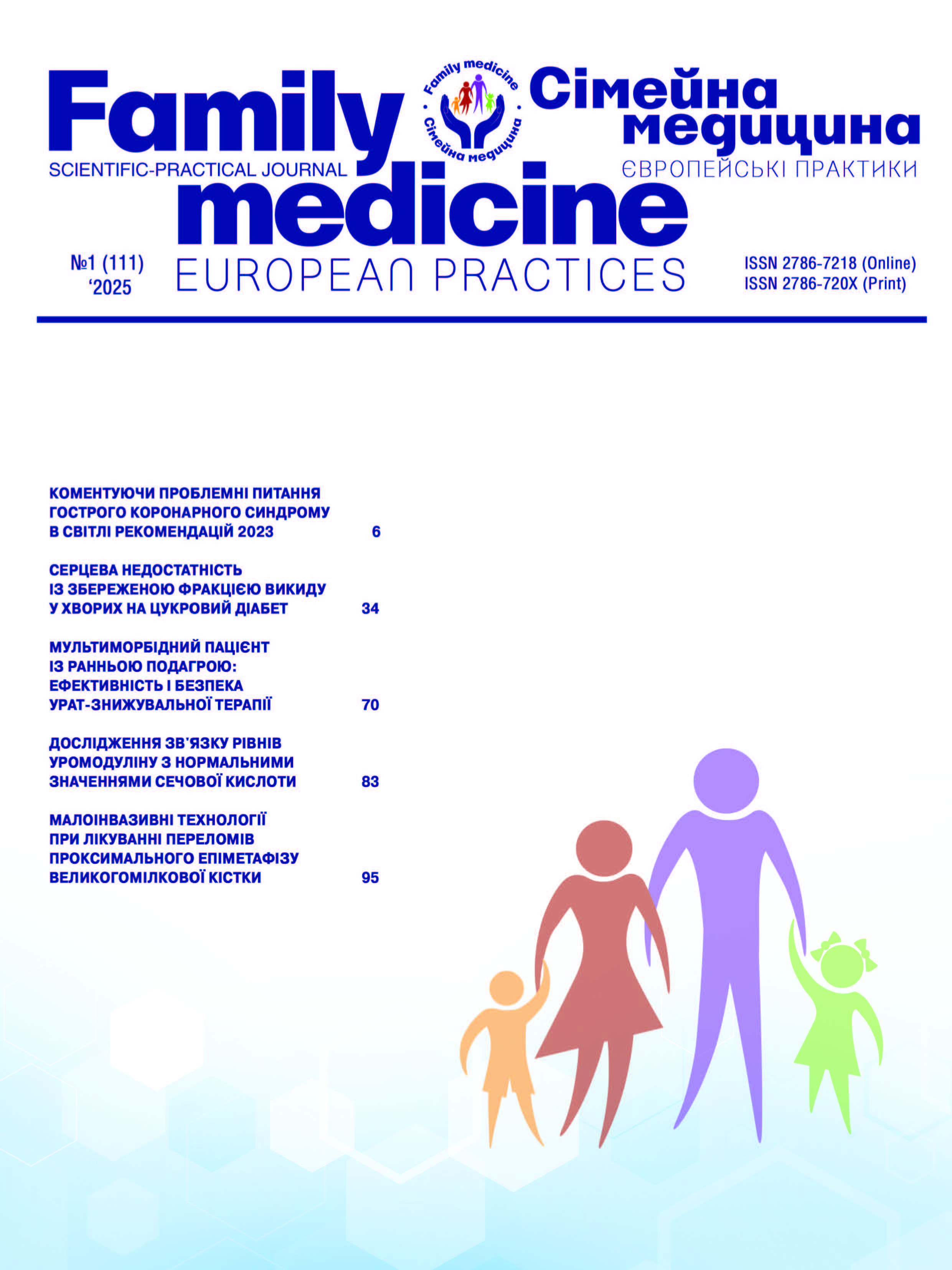Дослідження зв’язку рівнів уромодуліну з нормальними значеннями сечової кислоти
##plugins.themes.bootstrap3.article.main##
Анотація
Відомо, що екскреція уромодуліну (Umod) пов’язана із фракційними екскреціями сечової кислоти (UrAc), хлориду та натрію (маркерами об’ємного перевантаження). Проте на сьогодні ще не до кінця з’ясований зв’язок між Umod і UrAc крові (sUrAc).
Мета дослідження: аналіз зв’язку між рівнями sUrAc і Umod та оцінювання впливу sUrAc на Umod у моделі Umod-sUrAc.
Матеріали та методи. У 2021–2023 рр. у ТОВ «ВЕТА-ПЛЮС» та КДЦ Броварської багатопрофільної клінічної лікарні, що є клінічними базами кафедри нефрології та нирковозамісної терапії Національного університету охорони здоров’я України імені П. Л. Шупика, було проведено дослідження ROLUNT (uROmoduLin, UbiquinoNe, glutaThione). У дослідження увійшли 89 пацієнтів віком від 18 до 64 років з рівнем sUrAc менше 360 мкмоль/л, а саме: 63 пацієнта мали хронічну хворобу нирок (ХХН) 1–3 стадії, 26 пацієнтів – без ознак ХХН і/або гострого пошкодження нирок.
Результати. Аналіз обстеження пацієнтів і коефіцієнт кореляції Спірмена продемонстрував значний позитивний зв’язок між фракційною екскрецією Umod (FeUmod) та індексом альбумін сечі (uAlb)/креатинін сечі (uCrea), сечовий Umod (uUmod)/uCrea, сечовиною крові (sUrea), азотом сечовини (BUN), креатиніном крові (sCrea), індексом ризику розвитку термінальної стадії ХХН через 2 роки (QxMD2) та через 5 років (QxMD5); між uAlb/uUmod та віком, uAlb, uAlb/uCrea, QxMD2, QxMD5; між uUmod та добовим uUmod (uUmod24), uUmod/сироватковим Umod (sUmod); між uUmod24 та uUmod/sUmod, uUmod/рШКФ за формулою CKD-EPI (рШКФckd); між uUmod/uCrea та uUmod/рШКФckd, uAlb/uCrea; між uUmod/рШКФckd та uUmod24, QxMD2, QxMD5, uUmod/uCrea.
Висновки. Результати дослідження свідчать про складні взаємозв’язки між Umod і UrAc, що можуть впливати на стан здоров’я пацієнтів із ХХН. Відсутність кореляції між Umod та UrAc вказує на незалежні механізми регуляції цих показників.
##plugins.themes.bootstrap3.article.details##

Ця робота ліцензується відповідно до Creative Commons Attribution 4.0 International License.
Автори зберігають авторське право, а також надають журналу право першого опублікування оригінальних наукових статей на умовах ліцензії Creative Commons Attribution 4.0 International License, що дозволяє іншим розповсюджувати роботу з визнанням авторства твору та першої публікації в цьому журналі.
Посилання
Denova L. Uromodulin as a potential candidate marker for predicting the course of chronic kidney disease. Kidneys. 2022;10(4):237–43. doi: 10.22141/2307-1257.10.4.2021.247898.
Chen TK, Estrella MM, Appel LJ, Surapaneni AL, Köttgen A, et al. Associations of Baseline and Longitudinal Serum Uromodulin With Kidney Failure and Mortality: Results From the African American Study of Kidney Disease and Hypertension (AASK) Trial. Am J Kidney Dis. 2024;83(1):71–8. doi: 10.1053/j.ajkd.2023.05.017.
Karagiannidis AG, Theodorakopoulou MP, Pella E, Sarafidis PA, Ortiz A. Uromodulin biology. Nephrol Dial Transplant. 2024;28;39(7):1073–87. doi: 10.1093/ndt/gfae008.
Takata T, Isomoto H. The Versatile Role of Uromodulin in Renal Homeostasis and Its Relevance in Chronic Kidney Disease. Intern Med. 2024;63(1):17–23. doi: 10.2169/internalmedicine.1342-22.
Micanovic R, LaFavers K, Garimella PS, Wu XR, El-Achkar TM. Uromodulin (Tamm-Horsfall protein): guardian of urinary and systemic homeostasis. Nephrol Dial Transplant. 2020;35(1):33–43. doi: 10.1093/ndt/gfy394.
Denova L. The value of proteomic studies of the latest markers of kidney damage in the urine to assess the course, progression and complications in patients with CKD. Kidneys. 2022;11(2):68–80. doi: 10.22141/2307-1257.11.2.2022.363.
Wu CH, Yang CC, Chang HW, Huang B, Chen CJ, Lin EI, et al. Urinary Uromodulin/Creatinine Ratio as a Potential Clinical Biomarker for Chronic Kidney Disease Patients with Gout: A Pilot Study. Med Princ Pract. 2019;28(3):273–9. doi: 10.1159/000496844.
Ikeme JC, Scherzer R, Garimella PS, Hallan SI, Katz R, Estrella MM, et al. The Association of Plasma and Urine Uromodulin With Cardiovascular Disease in Persons With Hypertension and CKD. Am J Kidney Dis. 2024;84(6):799–802. doi: 10.1053/j.ajkd.2024.05.012.
Denova LD. Development of renal fibrosis in patients with chronic kidney disease: Mechanisms, biomarkers, and clinical implications. Ukr J Nephrol Dialysis. 2023;79(3):54–67. doi: 10.31450/ukrjnd.3(79).2023.08.
Bullen AL, Vaingankar S, Madero M, Lopez Gil S, Macedo E, Ix JH, et al. Urine Uromodulin, Kidney Tubulointerstitial Fibrosis, and Furosemide Response. Nephron. 2024;148(7):443–7. doi: 10.1159/000534578.
Gou R, Dou D, Tian M, Chang X, Zhao Y, Meng X, et al. Association between triglyceride glucose index and hyperuricemia: a new evidence from China and the United States. Front Endocrinol (Lausanne). 2024;(15):1403858. doi: 10.3389/fendo.2024.1403858.
Denova L. Evaluation of the index of resistance and excretion of uromodulin in patients with predialysis CKD, taking into account the index of comorbidity. Kidneys. 2024;13(2):101–15. doi: 10.22141/2307-1257.13.2.2024.45.
Du L, Zong Y, Li H, Wang Q, Xie L, Yang B, et al. Hyperuricemia and its related diseases: mechanisms and advances in therapy. Signal Transduct Target Ther. 2024;9(1):212. doi: 10.1038/s41392-024-01916-y.
Kim GH, Jun JB. Altered Serum Uric Acid Levels in Kidney Disorders. Life (Basel). 2022;12(11):1891. doi: 10.3390/life12111891.
George C, Leslie SW, Minter DA. Hyperuricemia [Internet]. In: StatPearls Treasure Island (FL): StatPearls Publishing; 2024. Available from: https://www.ncbi.nlm.nih.gov/books/NBK459218/.
Kushnirenko S, Savytska L, Bevzenko T, Rotova S, Lysianska O. Asymptomatic and Symptomatic Hyperuricemia: an Innovative Treatment Strategy. Fam Med Eur Pract. 2023;(3):63–70. doi: 10.30841/2786-720X.3.2023.289351.
Li Y, Zeng L. Comparison of seven anthropometric indexes to predict hypertension plus hyperuricemia among U.S. adults. Front Endocrinol (Lausanne). 2024;(15):1301543. doi: 10.3389/fendo.2024.1301543.
Zeravica R, Ilincic B, Buric D, Jakovljevic A, Crnobrnja V, Ilic D, et al. Relationship Between Serum Uromodulin as a Marker of Kidney Damage and Metabolic Status in Patients with Chronic Kidney Disease of Non-Diabetic Etiology. Int J Mol Sci. 2024;25(20):11159. doi: 10.3390/ijms252011159.
Melchinger H, Calderon-Gutierrez F, Obeid W, Xu L, Shaw MM, Luciano RL, et al. Urine Uromodulin as a Biomarker of Kidney Tubulointerstitial Fibrosis. Clin J Am Soc Nephrol. 2022;17(9):1284–92. doi: 10.2215/CJN.04360422.





